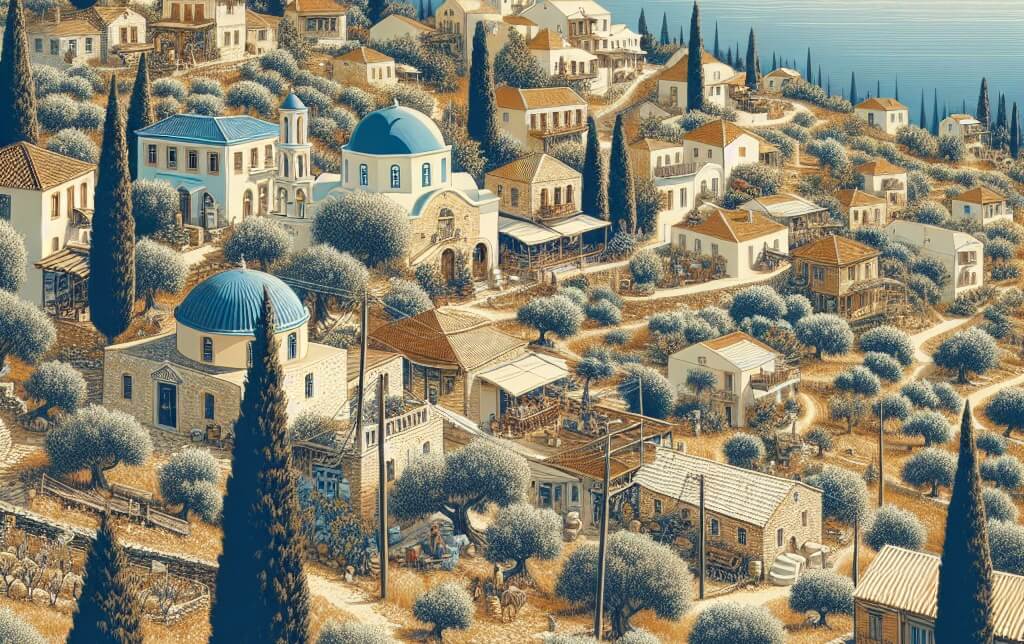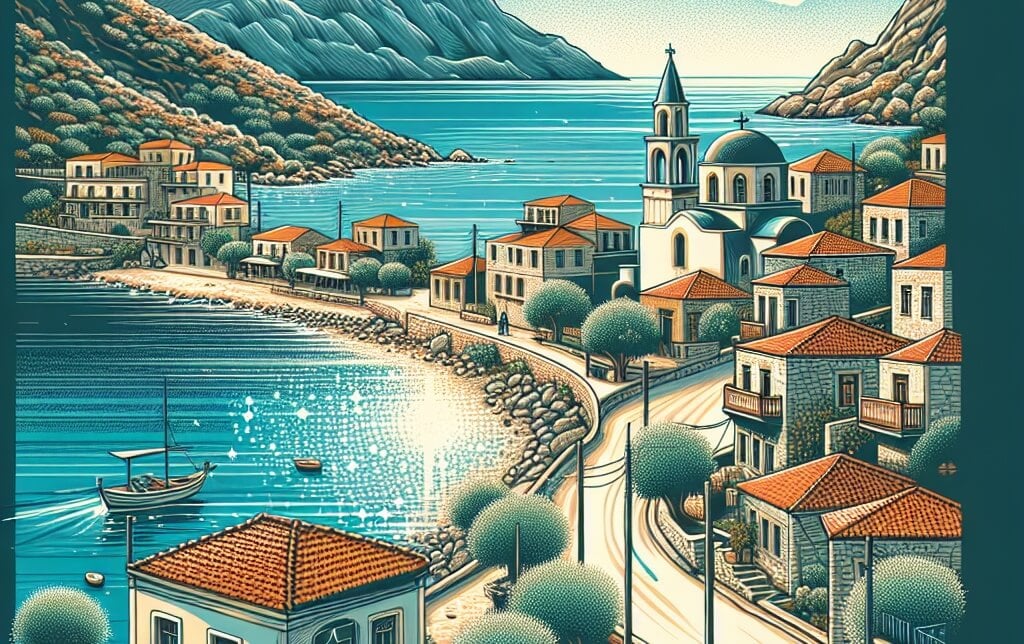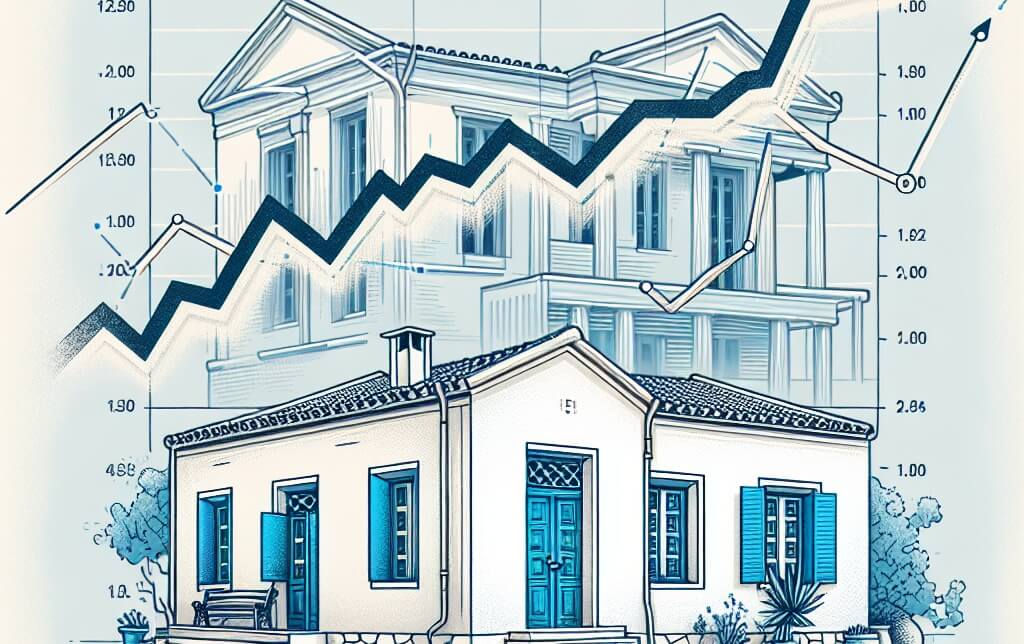
Milies Greece: Explore this Charming Village in Greece
Milies, Greece is a charming village located in the region of Thessaly, known for its picturesque scenery, traditional architecture, and rich history. This idyllic village is surrounded by lush greenery and offers visitors a peaceful retreat from the hustle and bustle of city life. With its cobblestone streets, quaint cafes, and stunning views of the Pelion mountains, Milies exudes a sense of old-world charm that captivates all who visit. The village is also home to several historical sites, including the famous Milies Train Station, which is a popular tourist attraction. Whether you are interested in exploring the local culture, enjoying the natural beauty of the area, or simply relaxing in a tranquil setting, Milies, Greece is a destination that promises a delightful and unforgettable experience.
Introduction
The introduction of families in Greece plays a crucial role in shaping the social fabric of the country. Family is considered the cornerstone of Greek society, with strong emphasis placed on kinship, loyalty, and support. The concept of family extends beyond the nuclear unit to include extended family members, creating a network of relationships that provide emotional and financial security. In Greek culture, family gatherings and celebrations are significant events that strengthen bonds and traditions. Understanding the dynamics of families in Greece is essential for comprehending the values and norms that guide interpersonal relationships and societal interactions in this Mediterranean nation.
Overview of Milies, Greece and its significance in the region.
Milies, a picturesque village located in the region of Thessaly in central Greece, holds significant historical and cultural importance in the region. Nestled in the lush greenery of Mount Pelion, Milies is renowned for its traditional architecture, cobblestone streets, and stunning views of the Aegean Sea. The village is a popular tourist destination, attracting visitors with its charming atmosphere and rich history dating back to the Ottoman Empire. Milies is also known for its connection to the Greek War of Independence, as it served as a meeting point for revolutionaries and played a pivotal role in the liberation of Greece from Ottoman rule. Today, Milies continues to preserve its heritage through various cultural events, such as the famous Milies Train, a historic steam-powered railway that offers scenic rides through the surrounding countryside. Overall, Milies stands as a testament to Greece's vibrant past and serves as a beacon of cultural significance in the region of Thessaly.
Historical Background
The historical background of Milies, Greece is rich and diverse, dating back to ancient times. The region has been inhabited since the Neolithic period, with evidence of human settlement found in various archaeological sites. Milies has been influenced by various civilizations throughout its history, including the Minoans, Mycenaeans, and Byzantines. The town played a significant role during the Ottoman occupation, serving as a center of resistance against the Turkish rule. In the 19th century, Milies became an important hub for trade and commerce, contributing to its economic prosperity. Today, the town's historical background is evident in its architecture, traditions, and cultural heritage, making it a fascinating destination for visitors interested in exploring Greece's past.
Discuss the historical context of Milies, Greece and its development over time.
Milies, Greece, holds a rich historical significance that dates back to ancient times. Situated in the region of Thessaly, Milies has witnessed various periods of development and transformation throughout history. The town flourished during the Byzantine era, serving as a significant cultural and economic hub. In the Ottoman period, Milies experienced a period of decline but managed to maintain its cultural heritage. In the 19th century, Milies played a crucial role in the Greek War of Independence against the Ottoman Empire. The town saw a resurgence in the 20th century, attracting visitors with its picturesque architecture and scenic surroundings. Today, Milies stands as a symbol of resilience, blending its rich history with modern amenities to offer a unique experience for visitors exploring the region.
Geographical Location
The geographical location of Milies, Greece, plays a significant role in shaping the town's characteristics and appeal. Situated in the mountainous region of Pelion in central Greece, Milies boasts a picturesque setting surrounded by lush forests and stunning views of the Aegean Sea. This location not only provides a tranquil and scenic environment for residents and visitors but also offers opportunities for outdoor activities such as hiking, skiing, and exploring the natural beauty of the region. Additionally, the proximity to the sea allows for a pleasant climate and access to fresh seafood, enhancing the overall quality of life in Milies.
Describe the geographical location of Milies, Greece and its surroundings.
Milies, a picturesque village in Greece, is located in the eastern part of the country on the Pelion Peninsula. Nestled amidst lush greenery and rolling hills, Milies is situated at an elevation of approximately 400 meters above sea level, offering stunning panoramic views of the surrounding landscape. The village is surrounded by dense forests, olive groves, and traditional stone-built houses, creating a tranquil and idyllic setting for visitors to explore. Milies is also known for its proximity to the Aegean Sea, with the coastal town of Kala Nera just a short drive away, providing easy access to beautiful beaches and crystal-clear waters. Overall, the geographical location of Milies in Greece offers a perfect blend of natural beauty and cultural charm for travelers seeking a peaceful retreat.
Transportation
Transportation plays a crucial role in the daily lives of families in Greece, facilitating mobility and connectivity within and between cities and regions. The diverse transportation network in Greece, which includes buses, trains, ferries, and private vehicles, enables families to commute to work, access essential services, and explore the country's rich cultural and historical heritage. Despite facing challenges such as traffic congestion and limited public transportation options in some areas, the transportation infrastructure in Greece continues to evolve and improve, contributing to the overall quality of life for families across the country. Efforts to enhance sustainable transportation solutions and promote accessibility are essential to ensuring a safe and efficient transportation system for families in Greece.
Milies Train
The Milies Train, located in Milies, Greece, is a historic narrow-gauge railway that offers visitors a unique and picturesque way to explore the stunning landscape of the Pelion region. The train, known for its charming old-world aesthetic and traditional steam locomotive, takes passengers on a scenic journey through lush forests, past rushing rivers, and alongside charming villages. The Milies Train provides an authentic and nostalgic experience, allowing passengers to step back in time and appreciate the beauty of the Greek countryside. Traveling on the Milies Train is a must-do activity for those seeking a memorable and enchanting adventure in the heart of Greece.
Explore the significance of the Milies Train in connecting Milies to other parts of the region.
The Milies Train holds significant historical and cultural importance in connecting the village of Milies to other parts of the region in Greece. Originally constructed in the late 19th century, the train played a pivotal role in facilitating transportation and trade between Milies and surrounding areas. Its operation not only provided essential connectivity for the local community but also served as a symbol of progress and modernization in the region. The Milies Train's route, winding through picturesque landscapes and crossing iconic bridges, attracted tourists and visitors, further enhancing the village's visibility and economic growth. Today, the Milies Train stands as a testament to the enduring legacy of infrastructure development and the enduring impact of transportation networks on regional connectivity.
Railway Construction
Railway construction in Milies, Greece has been a pivotal project in enhancing the transportation infrastructure of the region. The development of railways in Milies has not only facilitated the movement of goods and passengers efficiently but has also contributed to the economic growth and connectivity of the area. The construction of railways in Milies has been meticulously planned and executed, taking into consideration factors such as terrain, environmental impact, and safety regulations. The implementation of modern railway technology and infrastructure has transformed the transportation landscape of Milies, providing a reliable and sustainable mode of travel for the residents and businesses in the region.
Discuss the construction of the railway in Milies and its impact on the village.
The construction of the railway in Milies, Greece, marked a significant turning point in the village's development. Initiated in the late 19th century, the railway project connected Milies to the wider region, facilitating trade and transportation of goods. The construction process itself brought economic opportunities to the village, providing employment for local residents and boosting the local economy. Furthermore, the railway enhanced accessibility to Milies, attracting tourists and visitors to explore the picturesque village and its surrounding areas. This influx of visitors brought about a cultural exchange and stimulated the growth of the local tourism industry. Overall, the construction of the railway in Milies had a lasting impact on the village, shaping its economy, infrastructure, and cultural landscape.
Train Station
The train station in Milies, Greece serves as a vital transportation hub for both locals and tourists alike. Situated amidst the picturesque landscape of the region, the station provides a convenient and efficient mode of travel for those looking to explore the surrounding areas. With its well-maintained facilities and reliable train services, the station plays a crucial role in connecting the community to other parts of the country. Additionally, the station's historical significance and architectural charm make it a notable landmark in Milies, adding to the cultural heritage of the region. Overall, the train station in Milies, Greece serves as a symbol of both progress and tradition, embodying the importance of transportation infrastructure in fostering connectivity and economic development.
Highlight the importance of the train station in Milies and its role in facilitating transportation.
The train station in Milies, Greece, holds significant importance in the region by playing a crucial role in facilitating transportation. As a historical landmark and a central hub for connecting various parts of the country, the train station serves as a vital link for both locals and tourists. Its strategic location allows for easy access to neighboring towns and cities, contributing to the overall accessibility and connectivity of the region. The presence of the train station not only enhances the efficiency of transportation but also promotes economic growth and tourism in Milies and its surrounding areas. Its historical and cultural significance further adds to its value, making it an integral part of the local infrastructure and transportation network.
Architectural Influence
The architectural influence in Milos, Greece, is a reflection of its rich history and cultural heritage. The island's buildings showcase a blend of traditional Greek architecture with influences from various civilizations that have inhabited the region over the centuries. The whitewashed buildings with blue accents, characteristic of the Cycladic architectural style, are prevalent throughout the island, creating a harmonious and picturesque landscape. Additionally, the Venetian and Ottoman influences can be seen in the design of certain structures, adding a unique and diverse architectural charm to the island. Overall, the architectural influence in Milos serves as a testament to the island's vibrant past and enduring cultural significance.
Italian Engineer
An Italian engineer working in Milies, Greece would bring a valuable skill set and expertise to the local community. With a strong background in engineering principles and practices, the Italian engineer could contribute to infrastructure development projects, such as road construction, building maintenance, or energy systems improvement. Their knowledge and experience could help enhance the efficiency and functionality of various public works in Milies, ultimately benefiting the residents and fostering economic growth in the region. Furthermore, the cultural exchange between the Italian engineer and the local population could lead to a fruitful exchange of ideas and perspectives, enriching both parties professionally and personally.
Examine the role of Italian engineers in the construction and design of buildings in Milies.
Italian engineers have played a significant role in the construction and design of buildings in Milies, Greece. Known for their expertise and innovation in engineering, Italian professionals have contributed to the architectural landscape of Milies with their advanced knowledge and skills. Their involvement in various projects has led to the creation of structures that blend traditional Greek aesthetics with modern engineering techniques. Through their meticulous planning and attention to detail, Italian engineers have enhanced the overall quality and sustainability of buildings in Milies, leaving a lasting impact on the local community and the architectural heritage of the region.
De Chirico's Father
The painting "De Chirico's Father" by Giorgio de Chirico depicts the artist's father in a contemplative and introspective manner. Set against a backdrop reminiscent of the artist's hometown of Volos, Greece, the painting captures a sense of familial connection and heritage. Through his use of geometric forms and subdued colors, de Chirico conveys a sense of timelessness and emotional depth, reflecting the complex relationship between father and son. The painting serves as a poignant tribute to the artist's Greek roots and the influence of his father on his artistic development.
Discuss the influence of De Chirico's father, an Italian architect, on the architectural style of Milies.
The architectural style of Milies in Greece bears a significant influence from De Chirico's father, an Italian architect. De Chirico's father, being an architect himself, instilled in his son a deep appreciation for classical and neoclassical architectural principles. This influence is evident in the design of many buildings in Milies, characterized by symmetrical facades, grandiose columns, and intricate detailing. The attention to proportion, balance, and harmony in the architectural elements of Milies reflects the legacy of De Chirico's father and his commitment to timeless architectural aesthetics. The fusion of Italian architectural sensibilities with the local Greek context has resulted in a unique and captivating architectural style that defines the charm of Milies.
Mount Pelion
Mount Pelion, located in the town of Milies, Greece, is a majestic destination that offers breathtaking views and a rich history. This iconic mountain is renowned for its lush greenery, charming villages, and traditional architecture. Visitors to Mount Pelion can explore its numerous hiking trails, discover ancient ruins, and enjoy the serene beauty of the surrounding landscape. The town of Milies, nestled at the foot of the mountain, provides a picturesque setting for travelers seeking a peaceful retreat. With its combination of natural beauty and cultural heritage, Mount Pelion is a must-visit destination for those looking to immerse themselves in the beauty of Greece.
Mountain Slope
The mountain slope in Milies, Greece is a picturesque landscape characterized by its steep incline and lush greenery. The rugged terrain offers breathtaking views of the surrounding countryside and is a popular destination for hikers and nature enthusiasts. The diverse flora and fauna that thrive on the mountain slope contribute to the area's ecological richness and biodiversity. Additionally, the mountain slope in Milies serves as a vital watershed, providing a source of freshwater for the local community. Overall, the mountain slope in Milies, Greece is a natural wonder that showcases the beauty and resilience of the region's landscape.
Explore the impact of the mountain slope on the development and landscape of Milies.
The mountain slope has played a significant role in shaping the development and landscape of Milies, Greece. Situated on the slopes of Mount Pelion, Milies benefits from stunning panoramic views and a unique topography that has influenced both its architectural layout and economic activities. The steep terrain has encouraged the construction of terraced buildings, winding pathways, and intricate stone structures that blend harmoniously with the natural surroundings. Additionally, the mountain slope has facilitated the cultivation of olive groves, vineyards, and fruit orchards, which have been integral to the local economy and cultural identity of Milies. Overall, the mountain slope has not only contributed to the aesthetic beauty of Milies but has also shaped its history, community, and way of life.
Pelion Milies
Pelion Milies is a picturesque village located in Greece, specifically in the region of Magnesia. Nestled at the foothills of Mount Pelion, Milies is renowned for its natural beauty, traditional architecture, and rich history. The village is characterized by its cobblestone streets, stone-built houses, and lush greenery, creating a charming and idyllic atmosphere. Milies is also known for its historic railway, the "Moutzouris," which offers visitors a unique and scenic journey through the surrounding mountains. Overall, Pelion Milies is a destination that encapsulates the essence of Greek culture and provides a serene retreat for travelers seeking a peaceful and authentic experience.
Discuss the connection between Mount Pelion and Milies and its significance for the village.
Mount Pelion holds a significant connection to the village of Milies in Greece, as it serves as a defining geographical feature that shapes the identity and history of the community. The mountain's towering presence not only provides a breathtaking backdrop for the village but also offers opportunities for outdoor activities and tourism, attracting visitors seeking to explore its lush forests and scenic trails. Additionally, Mount Pelion has played a crucial role in the economic development of Milies, as its fertile slopes have supported agriculture and farming practices that sustain the local economy. Furthermore, the mountain holds cultural and historical importance for the village, with ancient myths and legends woven into its landscape, adding to the charm and allure of Milies as a destination for travelers seeking to immerse themselves in the rich heritage of the region.
Notable Figures
In the context of families in Greece, notable figures play a significant role in shaping the country's history and culture. These individuals often come from prominent family lineages that have made significant contributions to various aspects of Greek society, such as politics, business, and the arts. Notable figures are revered for their leadership, influence, and impact on the nation's development. Their legacies are celebrated and remembered by the Greek people, as they represent the embodiment of success, achievement, and prestige within their respective fields.
Anthimos Gazis
Anthimos Gazis, also known as Anthimos the Greek, was a prominent figure in Greek history during the 18th century. He was a scholar, theologian, and educator who played a significant role in the Greek Enlightenment movement. Gazis was born in Milies, Greece, a small village known for its intellectual and cultural contributions. His teachings and writings were influential in shaping the intellectual landscape of his time, advocating for education and modernization in Greece. Gazis' legacy continues to be celebrated for his efforts in promoting Greek language, culture, and identity.
Highlight the contributions of Anthimos Gazis, a notable figure from Milies, Greece.
Anthimos Gazis, a distinguished figure from Milies, Greece, made significant contributions to Greek intellectual and cultural life during the 18th century. Gazis was a prominent scholar, theologian, and educator who played a key role in the Greek Enlightenment movement. He is best known for his efforts to promote education and literacy among the Greek population, advocating for the establishment of schools and the translation of important texts into Greek. Gazis also made notable contributions to the fields of theology and philosophy, engaging in scholarly debates and producing influential works on various subjects. His dedication to the advancement of knowledge and his commitment to the cultural and intellectual development of Greece have left a lasting impact on the country's history and legacy.
Engineer Evaristo
Engineer Evaristo is a highly skilled professional who has made significant contributions to the engineering field in Milies, Greece. His expertise and dedication to his work have been instrumental in the development and improvement of infrastructure in the region. With a keen eye for detail and a commitment to excellence, Engineer Evaristo has successfully completed numerous projects that have had a positive impact on the community. His innovative approach to problem-solving and his ability to collaborate effectively with colleagues and stakeholders have earned him a reputation as a reliable and respected engineer in Milies.
Discuss the achievements and influence of Engineer Evaristo in Milies.
Engineer Evaristo was a prominent figure in the town of Milies, Greece, known for his significant achievements and lasting influence on the local community. As an engineer, he was instrumental in the construction of key infrastructure projects in Milies, such as the development of the town's water supply system and the renovation of its roads and bridges. His meticulous attention to detail and innovative problem-solving skills ensured that these projects were completed successfully and contributed to the overall improvement of the town's infrastructure. Engineer Evaristo's dedication to his work and his commitment to the betterment of Milies left a lasting impact on the town, setting a high standard for future development initiatives and earning him the respect and admiration of the local residents.
Surrounding Villages
The surrounding villages of Milies, Greece, offer a quaint and picturesque backdrop to the charming town. Nestled among the lush greenery and rolling hills of the Pelion region, these villages provide a glimpse into traditional Greek life and culture. From the cobblestone streets lined with colorful bougainvillea to the historic churches and traditional tavernas, each village exudes its own unique charm and character. Visitors to Milies can explore these neighboring villages to experience the authentic beauty and hospitality of rural Greece, making for a truly enriching and memorable travel experience.
Kala Nera
Kala Nera is a charming coastal village located in the region of Pelion in Greece. Known for its picturesque setting and relaxed atmosphere, Kala Nera is a popular destination for families seeking a peaceful and idyllic vacation. The village boasts beautiful beaches, traditional tavernas serving fresh seafood, and a variety of accommodation options to suit every preference. Visitors to Kala Nera can enjoy leisurely strolls along the promenade, explore the surrounding olive groves, or simply unwind on the sandy shores of the Aegean Sea. With its stunning natural beauty and warm hospitality, Kala Nera offers a quintessential Greek experience for families looking to create lasting memories in this enchanting destination.
Explore the relationship between Milies and the nearby village of Kala Nera.
The relationship between Milies and the nearby village of Kala Nera in Greece is characterized by a sense of interconnectedness and mutual reliance. Milies, a picturesque mountain village known for its traditional architecture and stunning views, serves as a cultural and historical hub for the region. In contrast, Kala Nera, a coastal village located just a few kilometers away, offers a different charm with its sandy beaches and lively waterfront. Despite their distinct identities, the two villages complement each other, attracting visitors seeking a diverse experience. The proximity between Milies and Kala Nera not only facilitates cultural exchange and economic opportunities but also fosters a sense of community among the residents of both villages. This symbiotic relationship showcases the rich diversity and interconnectedness of the region, making it a compelling destination for tourists and locals alike.
Ano Lechonia
Ano Lechonia is a small village located in the region of Magnesia, Greece. Situated near the picturesque town of Milies, Ano Lechonia offers a serene and charming setting for visitors seeking a peaceful retreat. The village is known for its traditional architecture, cobblestone streets, and stunning views of the surrounding mountains. With a rich history dating back centuries, Ano Lechonia provides a glimpse into the authentic Greek way of life. Visitors can explore the local shops, enjoy delicious Greek cuisine at the tavernas, and experience the warm hospitality of the residents. Whether for a day trip or a longer stay, Ano Lechonia offers a tranquil escape from the hustle and bustle of modern life.
Discuss the connection and interaction between Milies and the village of Ano Lechonia.
The village of Milies in Greece shares a deep connection and interaction with the nearby village of Ano Lechonia. Situated in close proximity within the lush surroundings of Mount Pelion, these two villages have historically maintained strong cultural ties and mutual support. Residents of Milies often visit Ano Lechonia for social gatherings, festivals, and community events, fostering a sense of camaraderie and shared identity. Additionally, the economic interdependence between the two villages is evident, as they frequently engage in trade and commerce, further strengthening their bond. The natural beauty and serene atmosphere of both Milies and Ano Lechonia complement each other, attracting visitors seeking a harmonious blend of tradition and tranquility. Overall, the connection and interaction between Milies and Ano Lechonia epitomize the spirit of unity and cooperation that characterizes the local communities in this picturesque region of Greece.









